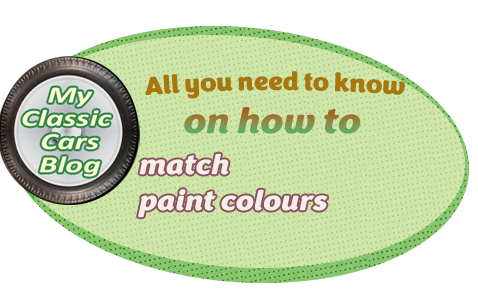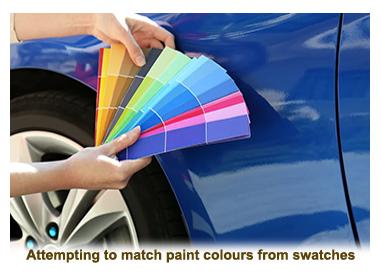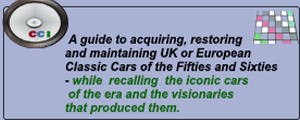
During restoration and especially for maintenance the challenge of matching paint colours can be a formidable one.
In many cases, the owner may not be aware of the actual colour, or if it has been resprayed the current paint may differ from what is indicated on the manufacturer's paint code plate.
Even if the vehicle’s original colour has been retained its inevitable y that time and the effects of UV exposure (even in the UK) have affected the paintwork.
 As a result, what my appear to be the codes will not accurately reflect the colour needed for patching or achieving seamless repairs on the body.
As a result, what my appear to be the codes will not accurately reflect the colour needed for patching or achieving seamless repairs on the body.
 Paint suppliers will have the equipment to analyse it and provide a formula for the specific colour needed., although this does not ensure a flawless match. While it may often be very similar, the colour can never be identical, as without having access to the entire vehicle, the paint manufacturer can only analyse the paint colour on a limited section of the panel to obtain a reading.
Paint suppliers will have the equipment to analyse it and provide a formula for the specific colour needed., although this does not ensure a flawless match. While it may often be very similar, the colour can never be identical, as without having access to the entire vehicle, the paint manufacturer can only analyse the paint colour on a limited section of the panel to obtain a reading.
 If the paint job is being done in-house, to achieve the best results, it's important to fade and blend the paint into the surrounding areas or panels., which should ensure that the transition between the old paint and the new is as seamless as possible and virtually invisible to the naked eye in natural light.
If the paint job is being done in-house, to achieve the best results, it's important to fade and blend the paint into the surrounding areas or panels., which should ensure that the transition between the old paint and the new is as seamless as possible and virtually invisible to the naked eye in natural light. To achieve the best result when matching paint colours, it is good advice to best
combine a number of methods. The first is use paint codes from suppliers. Many of the classic cars produced especially in the UK during the Fifties And Sixties featured distinct paint codes, such as “British Racing Green” and “Alpine White.” It must be taken into account however that as decades have gone past since they first left the paint booth, the original paint will have faded, meaning that a direct mix by purely by code is not liable to accurately match the current panels of the car.
The first is use paint codes from suppliers. Many of the classic cars produced especially in the UK during the Fifties And Sixties featured distinct paint codes, such as “British Racing Green” and “Alpine White.” It must be taken into account however that as decades have gone past since they first left the paint booth, the original paint will have faded, meaning that a direct mix by purely by code is not liable to accurately match the current panels of the car.  For that reason, most experienced paint shops prefer to use spray-out cards and test panels to evaluate the formula. They do so by preparing a small sample batch of paint which is sprayed onto a flat card or as large a panel as the possible of the original paintwork. After that the paint shop will compare the result directly with the car under natural light conditions.
For that reason, most experienced paint shops prefer to use spray-out cards and test panels to evaluate the formula. They do so by preparing a small sample batch of paint which is sprayed onto a flat card or as large a panel as the possible of the original paintwork. After that the paint shop will compare the result directly with the car under natural light conditions.
 Another tried and tested method favoured by paint shops, especially if the area to be covered is considerable is known as panel blending. Panel blending entails carefully matching the new paint precisely to the old along a single line, even if they run into neighbouring panels, causing the blend transition to be less noticeable to the eye.
This is particularly beneficial when only a section of the car is being repainted, rather than undergoing a complete bare-metal respray.
An experienced spray painter/colourist are able to visually tint and adjust paint by eye until it achieves the desired match.
Another tried and tested method favoured by paint shops, especially if the area to be covered is considerable is known as panel blending. Panel blending entails carefully matching the new paint precisely to the old along a single line, even if they run into neighbouring panels, causing the blend transition to be less noticeable to the eye.
This is particularly beneficial when only a section of the car is being repainted, rather than undergoing a complete bare-metal respray.
An experienced spray painter/colourist are able to visually tint and adjust paint by eye until it achieves the desired match.
 This tried and tested method will take more time and demands a certain level of skill, yet it can be the sole approach to achieve unique patinas or non-standard shades. Unfortunately, it comes with a considerable price tag.
In recent years, the majority of professional paint shops have begun to use a
piece of equipment known as a digital matching spectrophotometer. As their name suggests, digital matching spectrophotometers can come with a hefty price tag, often reaching as high as five figures, meaning that they are out of the range of the casual or semi-professional car sprayer.
Hand-held, the spectrophotometer readily analyses any size of paint surface and will rapidly produce a formula for contemporary paint mixing systems.
This tried and tested method will take more time and demands a certain level of skill, yet it can be the sole approach to achieve unique patinas or non-standard shades. Unfortunately, it comes with a considerable price tag.
In recent years, the majority of professional paint shops have begun to use a
piece of equipment known as a digital matching spectrophotometer. As their name suggests, digital matching spectrophotometers can come with a hefty price tag, often reaching as high as five figures, meaning that they are out of the range of the casual or semi-professional car sprayer.
Hand-held, the spectrophotometer readily analyses any size of paint surface and will rapidly produce a formula for contemporary paint mixing systems.
 It does so by using a visible spectrum of light reflection from a surface is measured by a spectrophotometer, that records information on brightness, saturation, hue, and faint undertones that the human eye is rarely capable of measuring. These readings are then transformed by connected software into a paint mixing formula.
It does so by using a visible spectrum of light reflection from a surface is measured by a spectrophotometer, that records information on brightness, saturation, hue, and faint undertones that the human eye is rarely capable of measuring. These readings are then transformed by connected software into a paint mixing formula.
It is now generally recognized that the arrival of the digital matching spectrophotometer has signalled a revolution in matching paint colours, taking the majority of guesswork out of once was a very time consuming and frustrating experience for the spray painter.
pw3

